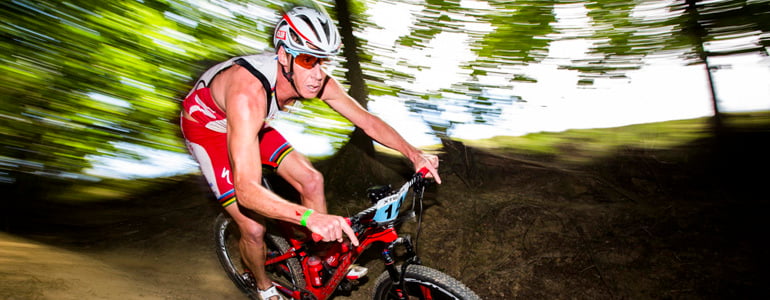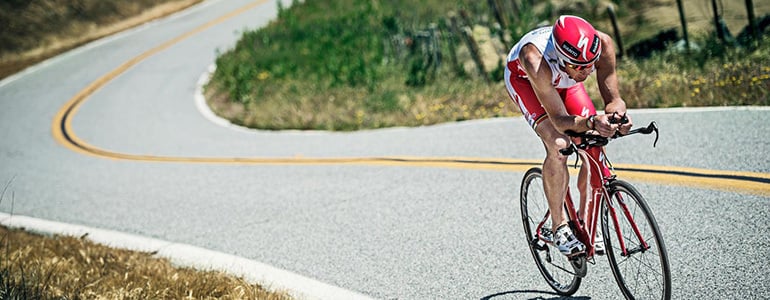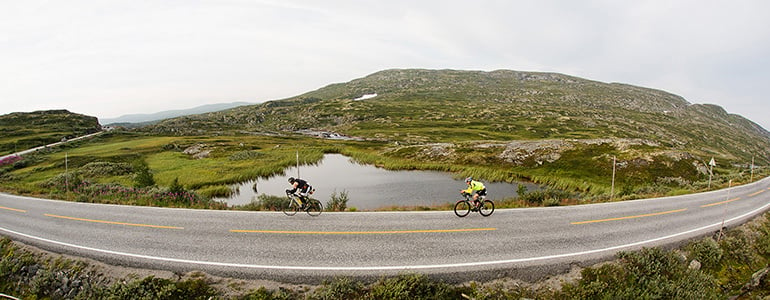

Suunto Blog

Caveman's awesome fatbike adventures
Seven-time world triathlon champion Conrad Stoltz, aka Caveman, says having a lot of hobbies has helped him stay mentally fresh as an athlete.
One of those hobbies is riding his Fatboy fatbike to hard-to-get-to places. A fatbike is a bicycle with over-sized tires designed for riding on soft, unstable terrain, such as snow and sand. Conrad's fatbike is a Specialized Fatboy Pro with 4.6inch (12cm) wide tyres, at super low pressure so he can ride just about wherever he likes!
Conrad tearing up dust on his fatbike. © Conrad Stoltz“A fatbike is so amazingly capable, you don't need a road or a path to ride,” Conrad says. “As long as there’s not too much vegetation, you can ride almost anywhere.
"Whether it's rocks or sand or gravel or whatever it is, you can just ride. “I love it because it satisfies my sense of adventure and being the Caveman wanting to see what's around the next corner and wanting to see if I can ride over big rocks, domes and dunes and find really cool places.”
Conrad likes his fatbike so much that he sometimes struggles to make himself train on his standard mountain bike “Once I'm less focused on training for performance and more just making it a lifestyle, I will definitely be doing more fatbiking,” he says.
Check out Conrad’s video of a fatbike adventure he did while attending a sporting festival on South Africa’s south coast.
Main image: ©lighttrapper.co.uk

Training and recovery wisdom from the Caveman
As you might expect from someone with the nickname of ‘caveman’, Conrad Stoltz is not into fads when it comes to recovery. Not for him ice baths and compression socks. He prefers to do what’s proven. Train right, eat right and rest properly. So why don’t you like ice baths? I've reverted back to old school! I used to do the ice bath thing or jumping in a cold river after training. But getting in a freezing river after training is not worth it to me! Science hasn't really proven that ice baths help.What about compression? There is a lot of evidence there...?I've done the compression socks thing but they don’t fit well and there's no real definite proof that compression socks make a big enough difference.
Warning: don't refuel properly and you'll never recover. ©zooom.at/Markus Berger
So what do you do? The things that are proven to make a difference – fueling and rehydrating properly. Within the first half an hour of training you need to have so many grams of carbs and so much protein to start the recovery. [Advice varies but many sports nutrionists recommend following the for 3:1 carbs to protein ratio.]
From pancakes to paragliding. See how the rest of Suunto's athletes recover.
Anything else?Massage is key. It’s not only for recovery, but also injury prevention. It’s crucial. The other big thing many athletes overlook is that they need to leave enough time between workouts to be able to complete those workouts at the required intensity.
Take your off-season seriously and do other activities, like go fishing. ©Conrad StoltzYou mean rest? A lot of athletes just want to log as many hours as possible in the logbook and then tally the hours to feel like they did a good job. For me and my coach, what's more important is that when I do the big quality workouts, I hit the numbers. Did I do the right amount of watts? And to be able to do that you need to be able to get to the session fresh, which means the day or two or three before you need to train very little so when the big session comes you can go hard. Recovery between key sessions is important. What’s the key to your long career? It's the fact I'm able to keep it fresh by having hobbies and activities. If I had to ride on the road every single time like the Ironman guys do I would never be able to make it! Stay mentally fresh by changing the environment where you are. Mental freshness is key.
Conrad Stoltz has been an elite pro athlete for over 20 years. He must be doing something right. ©Nils Nilsen
What about off season? It's key. Don't think about triathlon, you're not going to lose all your fitness. Go surfing, go jogging, or go hiking or even ride a motorbike, just keep active! By the time you start training again you're eager to train because you really want to do it not because you feel you have to. When you wake up in the morning and you're not looking forward to training it's one of the first pointers towards over-training. So training should be fun? Training is not always fun. Sometimes you have to hurt yourself. But in terms of the big picture, it needs to be enjoyable, rather than seeing how much you can punish yourself.
Take your recovery more seriously and improve your performance. Find out how the Suunto Ambit3 can help.
Main image: ©zooom.at/Markus Berger

Recover like a pro
What is the best way to recover after a race, adventure or just a hard effort on your own? We asked our ambassadors how they do it. From eating pancakes to paragliding, from secret smoothie recipes to stretching, their answers will help you get back on form more quickly.
KILIAN JORNET Stay fresh by doing other sports I like to do some mountaineering activities to feel different feelings than just running. I ran less than 200 km in the build up to Hardrock because I was climbing instead. I was keeping myself fit through mountaineering so when I came to the race I was mentally fresh and physically prepared.
Kilian stretches ©jordo canamerasAvoid over-trainingIf you focus too hard on one thing for too long you can get tired of it. You see people who are doing a lot of long races and who keep this up for one or two years and then, boom, they’re down and injured. It’s important to never do too many long races every year because after one, two or three years it can be really hard to recover. For me, 200 or 300 miles a year is the limit.
Kilian Jornet is a multiple record breaking trail runner, endurance athlete and world champion ski mountaineer.
EMELIE FORSBERG Rest! Normally I rest the day after or if it is an ultra at least. If I do a 2-4 hour race I normally go for a small run just to get the circulation going. I also like to treat myself after a race, like foot bath, compex [electrostimulation] take time for yoga, things that are easy and good for the body. Then my mind feels recovered and is soon ready for another hard training week or racing. I think the mind is very important for recovering.
Emelie likes to practise yoga and eat pancakes. ©Emelie Forsberg
Eat pancakesAfter an ultra, where you empty your body quite a lot and also eat chocolate or gels, I like to eat fresh and healthy, at least the first and second day. But pancakes is a standard the morning after, and yes I think pancakes can be pretty healthy..! Specially if I make banana pancakes :)
Emelie Forsberg is a European and world Skyrunning champion
CONRAD STOLTZ
Forget ice baths I don’t go in for compression or ice baths. I used to jump in a cold rivers after training but I'm over it! Compression socks don’t fit well and science hasn’t really proven that ice baths work.
Old school fan: Conrad Stoltz doesn't go in for ice baths or compression. ©zooom.at/markus berger
Refuel properlyBut there are things that are proven to make a difference, fueling and rehydrating properly. Within the first half an hour of training you need to have so many grams of carbs and so much protein to start the recovery. [Advice varies but many sports nutritionists recommend following the for 3:1 carbs to protein ratio.]
Conrad Stoltz is a four-time XTERRA World Champion triathlete
ÅSA LUNDSTRÖM
Easy rideGo on a very easy bike ride. It helps the circulation going and speeds up the recovery. If the weather is bad or biking is too much trouble (mentally), I sometimes go for an easy walk or stroll.
© Åsa LundströmMassage In big blocks of training, a massage every now and then is very good for recovery, muscle relaxation and preventing injury. It can also be considered a treat for your body after some hard work and helping you relax. I get the massage after a big day of training, as the thing of the day.
UELI STECK
ElectrostimulationI use compex electrostimulstion and try to stretch a lot. Rest days are also good. I just had a rest day so I ran easy the vertical km up to Brevant in Chamonix. I had a drink with a friend then went paragliding.
Ueli Steck during his mission to climb all 82, 4000 m mountains. ©PatitucciPhotoWarm down after exercise I move between 7 and 14 h per day. You start easy the first 30 min and you end the same way. So you have your warm-up and cool down. If possible I try to get my feet in a cold stream.
MATTHIAS SCHERER
Respect your body I really have to say that in the adventure world at the moment recovery and nutrition is not taken seriously. People are strange about hydration. They wear a Suunto Ambit, have the best equipment and then they drink snow water and don’t take things like this seriously! Take electrolyte capsules with minerals to rehydrate properly.
Matthias front lifting weights. ©Tanja SchmittAvoid processed foodsTry to go as long as you can on normal food and then you can start to eat energy bars etc. People push the limits of eating concentrated food which can cause stomach problems. Eat a peanut butter sandwich.
Bring it down slowlyFor recovery it’s important not to stop right away after an ice climbing season. I used to become ill in April when I stopped. Now I continue with skiing and in June and July I keep going to the mountains. I've found cycling helps me to mentally digest everything I've done over the winter. In a week I try to do at least 20 hours on the bike. I work on my films. That's my way of recovery.
Matthias Scherer is a professional ice climber
GREG HILL
Smooth operatorAs a ritual I always have a smoothie after my sporting activities. As quick as I can I am at my blender mixing in my ingredients. Bananas, blueberries, protein mix, raw cacao, milk. That is the base for the majority of my shakes, each food is strong in its own way, combining for a strength building, body recovery, tasty beverage.
Greg making a smoothie at home ©zooom.at/Markus Berger Cross TrainingAnother bit about an ageing body is balance. If over the course of your life you have created imbalances, they become more problematic in later years. To counter act I have been going to the gym to create an overall body fitness not just one designed for peddling a bike or skinning up mountains. Back problems, IT-band issues, all come from unbalance, so cross training is key.
Take some time outAlso to truly have days off. Not partial days off. But couch surfing, suntanning, doing nothing days. You can get away with just one but at least every two weeks to take 2-3 days completely off. This truly helps my body as well as my mind. I come back and feel so much better than if I had pushed through on that extra day of exercise.
Greg Hill is a pro skier. In March 2014 he skied 100,000m in a month
WILLIAM TRUBRIDGE Sleep and eat right “Recovery is as equally important as training. In freediving when you hold your breath it generates a huge amount of carbon dioxide which makes your body very acidic and means all those free radicals cruising around doing damage. Being able to target that with diet that's very rich in antioxidants and making sure you're sleeping right is important.” Drink this:
Will Trubridge's recovery smoothie
My go-to recovery drink after deep training is a green smoothie, with the following ingredients: 1 frozen banana (makes the smoothie cold and creamy) 1 cup almond milk + water added to get the right consistency 2 tbsp Manitoba hemp protein (the best vegetal protein source) 1 tbsp cacao powder (great antioxidant qualities) 1 tbsp Hawaiian spirulina (nature's multivitamin, with many other superfood ingredients like chlorophyll, omega 3,6,9 fatty acids and more) 1 tsp beetroot extract powder (great for blood-building)Everything is blended together, and topped with a dusting of granulated bee pollen.
Will Trubridge is a multiple record breaking freediver
Still need tips on how to recover? Well go explore the recovery options available with the Ambit3

Meet the Norseman!
This weekend sees one of the world’s toughest triathlons take place, the Isklar Norseman. It’s a unique unsupported triathlon featuring a 3.8km swim in the frigid waters of the Hardangerfjord, a 180km bike ride, and is followed by a full marathon with a sting in the tail – an ascent of 1,800 m Gaustatoppen. The total ascent is 5,000 meters. Entrants are warned that they may get ‘unusually emotional’. On the start line will be pro-triathlete and elite Ironman athlete Teemu Lemmettylä. And he’s going out to win. One day before the race, he gives us the race lowdown.
The Norseman proves too much for one competitor. ©agurtxane concellon
Why do it?
The history and the fame of the race… it’s the most challenging xtri competition!
Physically, how much more challenging is it than a regular Ironman? It’s hard to say because Ironman is always an all-out effort. Pushing too hard at the beginning is much more costly in this type of race. I expect that the bigger difference compared will be on the mental side. You have to keep your head together.
The marathon ends with a brutal ascent of Gaustatoppen. ©Jóse luis hourcade
How have you had to prepare differently? On cycling I have had to spent more time in up-hills during the training camps and generally put more focus on cycling because the bike leg is challenging and takes a long time. I have been working on my uphill running and used much more trails. However running hours have been similar to previous years.
Teemu Lemmettylä is an elite Ironman athlete. ©Teemu Lemmettylä
Are you concerned about conditions? Weather can range from beautifully sunny to blizzard? Training in Finland contains enough cold and bad weather which should not be a problem!
Do you think you can win? Anything is possible. On regular triathlon I should be the best from the pack. But this is my first Norseman – it’s just impossible to say for sure.
The race begins with an early start – and a cold one! ©Dag Oliver
Main header image: ©Jóse luis hourcade

Climb every (4,000 m) mountain
How’s the adventure been so far? It’s just so much fun. The weather has been great so far and I’m doing something almost every day. Sometimes of course there are days you are a little tired but that’s normal. I don’t feel wasted. I am super motivated and I am super happy. I have to say even if I don’t climb all 82 summits, by the end I would still be totally happy. I had just a great time so far. It’s just very cool being in the mountains, meeting people, going climbing, running cycling etc. The supporter is my best friend Daniel Mader.
Peak 41 of Ueli Steck's 82 Summit project. The Zinalrothorn above Zermatt marks the halfway point of his goal to climb all 82 4000 meter peaks in the Alps, using human-powered transport alone. ©PatitucciPhotoThe hardest part? I don’t know. When we did the Monterosa traverse, which was 18 peaks in a day, Andreas Steindel and I did get a little tired at the end! He is a mountain guide and part of the Swiss ski-mountaineering team. He knows the area very well so we just linked all these peaks. It was a great day out. I also climbed later the Weisshorn Bishorn in very bad weather. It was icy and snowy. I was completely in the fog. That was not a great moment.Has this project taught you anything new? Yes you don’t have to go far away to have a great time. Also in the Alps you can find still great challenges!What inspired you to create and do this project?It was the challenge of the whole journey. Being able to move so much and also the challenge with the weather and the conditions on the mountains!How has your climbing philosophy evolved? Before I was just focused on performance and pushing the limits in alpinism, recently in the Himalaya on the high peaks. But I am also not 20 anymore! I try to find the right balance in my life. I know I pushed myself to the edge, taking risk and pushing the limits on the 8000 m peaks. This is a one-way street. You will not survive this long-term. So of course I would like to go back to the Himalaya and climb 8,000 m peaks. But in the same style that I Annapurna? No, this I will not repeat. This game you survive only once in life.... But there are still great adventures to live!!!*Note: This interview was made with Ueli before last Wednesday’s accident in which Dutch climber Martijn Seuren died on the Rochefort Arete in the Mt Blanc massif. Contrary to some online reports, he was not part of Ueli’s project, but Ueli was at the scene afterwards. You can read his statement here.

Competition Freediving: the secret to doing well
Will Trubridge explains the importance of psychological strength in freediving competitions – and why having a poker face is a very useful skill. To the observer, freediving is all about serenity and calmness – a peaceful interaction with the underwater world. It is exactly all these things, which is why competition freediving presents such a unique challenge, says Will Trubridge.
“The conditions of a competition are slightly different to a world record attempt. In a competition you have an official preset time and there's a lot more people around – spectators and media. It's not as controllable as with a world record attempt,” he says.
Trubridge surfaces after a competition dive at Dean's Blue Hole ©zooom.at/Samo VidicThe key ingredient to success is to be relaxed he says, which is much harder to achieve in the contest environment. “With other sports you can use the nerves and the anxiety which generates adrenalin to your advantage. In freediving it's completely detrimental.”The reason for this is the affect it has on heart rate. Stress and anxiety raises the heart rate. To be successful, freedivers need to have the lowest pulse possible to conserve oxygen. Trubridge is currently preparing for the AIDA Apnea Depth World Championship in Cyprus this September after a successful spring in which he won all titles and set a new competition No Fins personal best (PB) of 98m in Colombia. He says he’s getting better at handling the stresses of contests.
“I’m feeling really motivated for [Cyprus]. The lesson I've been learning a lot this year is the importance of being patient and taking my time and not feeling obliged to do a dive.”He also says that mind games play a part. When going for a world record or when competing at his own Suunto Vertical Blue contest, a freediver can have multiple attempts over several days. But in the world champs, they get just one chance. And that involves some psychological battles. “You announce your dive on that day. If something goes wrong, then you don't have a second chance. It creates more of an element of chance. There is also a lot of sleuthing and spying to find out what other freedivers have done in their training to gauge how they're performing, and using that information to make pronouncements.”
Watch as Will Trubridge attempts to break his own 102m record.
He says that if he underestimates a competitor’s ability and sets himself a target that’s too low, he risks losing, but set the target too high and the risk is to over-stretch and fail. “It creates an element of a poker game in the announcements themselves!” he adds. Trubridge says he’s can’t wait for the contest to begin. “I've never been to Cyprus. My goals are to do well in all three disciplines. I have the world records in no fins and free immersion. I would like to do my best at winning gold in those two disciplines and do as best as I can in constant weight.”We wish him the best of luck.










































































